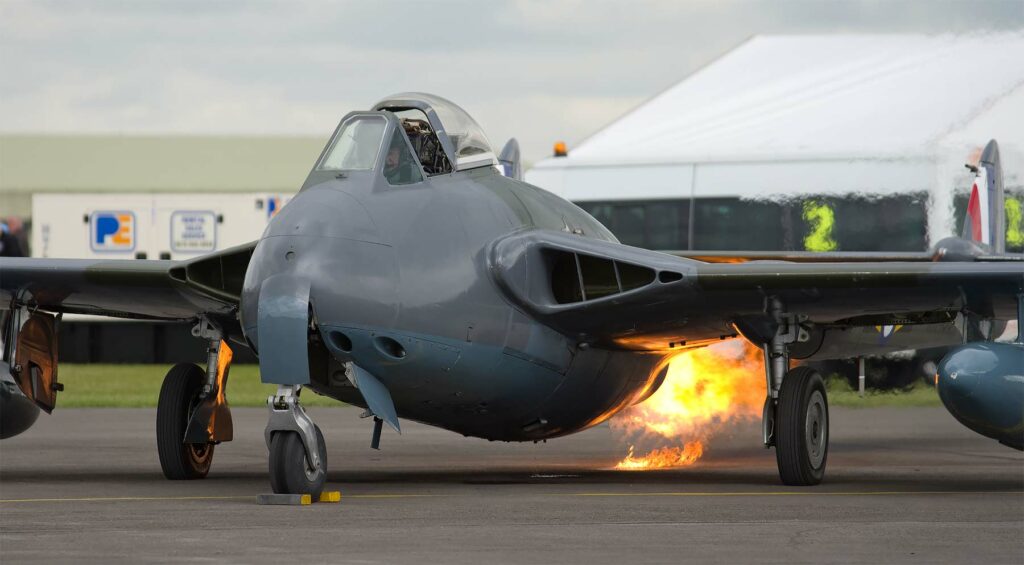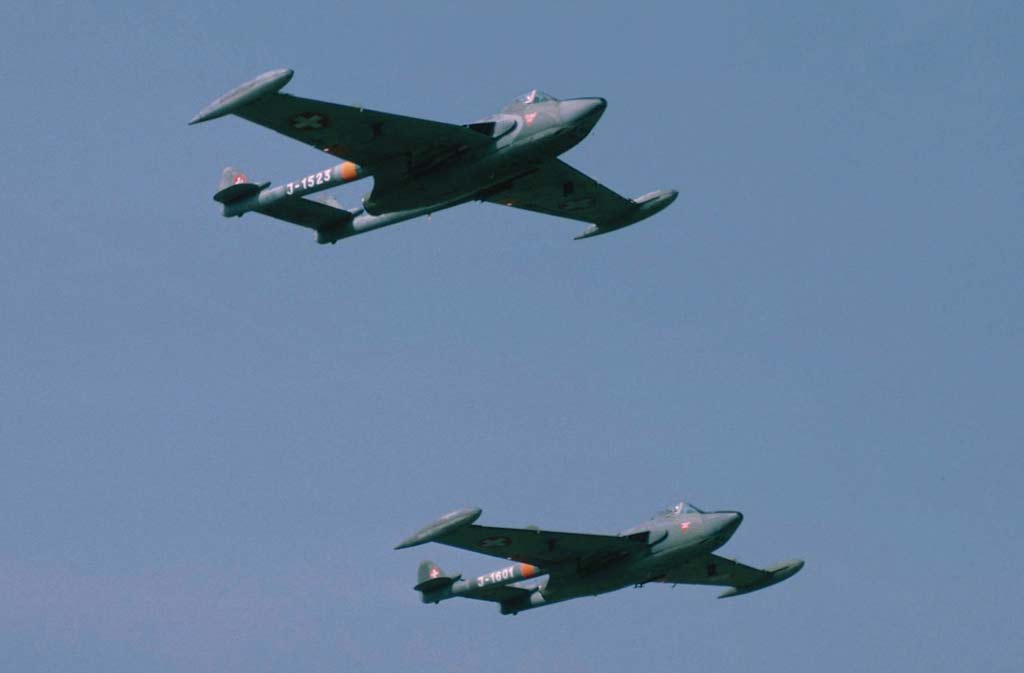The DH.112 Venom is a British post-WWII single-engine jet fighter-bomber, known for its speed and versatility.
In brief
The de Havilland DH.112 Venom was a British jet aircraft developed as a successor to the Vampire. As a fighter-bomber, it served in the RAF and numerous other air forces, seeing extensive service during the 1950s and early 1960s. Known for its distinctive twin-boom tail and high performance, the Venom was used in various roles, including ground attack, reconnaissance, and interception. Its combat service included actions in the Suez Crisis and operations in the Middle East and Africa. Despite being eventually outclassed by newer fighters, the Venom was a key transitional jet that combined operational flexibility with robust performance.
In the early post-World War II era, as jet technology rapidly evolved, the de Havilland DH.112 Venom was developed to provide the Royal Air Force and allied air forces with an advanced jet capable of multiple combat roles. It represented an important step in the evolution of military aviation, combining speed, agility, and firepower in a versatile airframe.

History of the Development of the de Havilland DH.112 Venom
Post-WWII aviation saw rapid advancements, with jet-powered aircraft becoming the new standard for military might. The de Havilland DH.112 Venom was developed in this context to address the need for a faster, more powerful, and versatile aircraft compared to its predecessor, the Vampire. De Havilland, known for their innovative designs, launched the program with the objective of enhancing performance, payload capacity, and operational flexibility.
The Venom first flew on 2 September 1949, entering service in the mid-1950s. While it didn’t receive a specific NATO nickname, its deployment marked a significant evolution in jet fighter-bomber capabilities, reflecting the increasing demands of Cold War aerial warfare. The development was driven by the need for a robust platform capable of delivering nuclear and conventional weapons, providing reconnaissance, and securing air superiority.
Design of the de Havilland DH.112 Venom
The DH.112 Venom’s design was an evolution of the Vampire, featuring a distinctive twin-boom tail and a more powerful Ghost engine. It was constructed using a mixture of metal and wood, characteristic of de Havilland’s innovative approach. The aircraft measured around 31 feet in length and 41 feet in wingspan (approximately 9.4 meters by 12.5 meters), striking a balance between compact size and performance.
The Venom’s design brought several advantages, including improved speed, altitude capabilities, and greater weapons payload. However, it also faced drawbacks such as limited range and some handling issues at high altitudes. Despite these challenges, the Venom’s robust design and adaptability made it a valuable asset across various operational theaters.
Performance of the de Havilland DH.112 Venom
The Venom’s performance was a significant improvement over its predecessor. Powered by the de Havilland Ghost 48 turbojet, it achieved a top speed of over 640 mph (1,030 km/h) and could reach altitudes of around 38,000 feet (11,600 meters). Its operational range extended to approximately 1,000 miles (1,600 kilometers) with external fuel tanks.
In comparison to contemporaneous aircraft, the Venom held its own in terms of speed and agility. Its performance made it a formidable opponent against early-generation jet fighters and an effective ground-attack platform. However, as aviation technology progressed, it was eventually outclassed by more advanced designs.
Variants of the de Havilland DH.112 Venom
The Venom saw several variants, each designed for specific roles or to incorporate technological advancements. Notable variants included the Venom FB.1, the initial fighter-bomber version; the NF.2, a night fighter variant; and the FB.4 with improved avionics and engine. Export versions were also developed, tailored to the needs of international operators. Each variant represented refinements in performance, capability, and reliability.

Military Use and Combat of the de Havilland DH.112 Venom
The Venom served in various military operations, demonstrating its versatility as a fighter-bomber. It saw combat in the Suez Crisis, as well as in counter-insurgency operations in Aden, Oman, and Kenya. Its roles included ground attack, air defense, and tactical reconnaissance, proving effective in both conventional and irregular warfare settings.
The aircraft was exported to several countries, including Switzerland, Sweden, and New Zealand, among others. Over time, as newer, more capable aircraft entered service, the Venom was phased out. However, its legacy continued in the operational doctrines and strategies it helped shape.
The de Havilland DH.112 Venom exemplifies the post-WWII era’s rapid advancements in military aviation. As a versatile and powerful jet fighter-bomber, it contributed significantly to air operations during its service life. Despite being eclipsed by newer generations of aircraft, the Venom’s impact on aerial warfare and its role in transitioning to modern jet combat tactics remain notable. Its legacy lives on as a symbol of the innovation and adaptability characteristic of the period’s aviation developments.
Back to the Fighter Jet section.